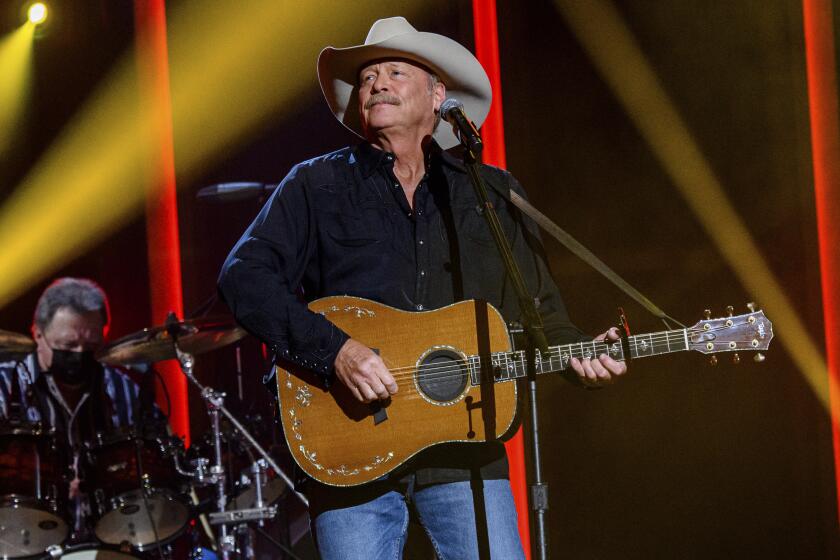Beneke’s Still in the Swing of Things
- Share via
It’s a weird sensation, holding a Tex Beneke CD in your hand that’s dated 1996--and knowing it’s a new album, not a reissue or an anthology. Who even would have suspected that the old guy is still alive and kicking, must less actively performing?
But Beneke--best known for his stint as a tenor saxophonist and singer with the Glenn Miller Orchestra way back in the ‘30s and ‘40s--still lives, kicks and performs. Though he no longer plays the sax, he’ll sing and lead his own band tonight at the Mission San Juan Capistrano.
The 82-year-old--who lives in Santa Ana, and whose new CD is called “In the Miller Mood” (released by Florida Public Broadcasting)--has led his own big band since Miller’s mysterious death in 1944 in an apparent plane crash. Like some denizens of the Twilight Zone for whom times never change, Beneke has kept the sound and spirit of the swing era preserved for half a century past its time. He has the strong, assured speaking voice of an old-time radio personality and the affable charm to go with it.
“I have a lot of friends out here,” he said of Orange County, where he has lived since 1980. “We did a lot of work out here, there’s a lot of fine musicians out here and the whole bit. After my last wife passed away, I married a Southern California girl, and we’re doing just beautifully. Everything’s going great. I’m as active as I can be with conditions the way they are.
“The big bands have kind of taken a backseat the last few years. I get up to Chicago every so often, but I play Florida mostly. I just take the hit-and-miss jobs, which is really all I want at my age anyway.”
Gordon Lee Beneke was born in Fort Worth, Texas, and took up the saxophone as a child. After graduating from high school, he played in the Cleveland-based Ben Young Band, where he was scouted by the legendary drummer Gene Krupa. Krupa recommended Beneke to the then-little-known Miller, who was getting his first orchestra organized in New York City.
Miller offered Beneke a job, and at first the young saxman was something less than enthusiastic--until he managed to get Miller to guarantee him $2.50 a week more than the other musicians would be getting.
“When I got the call back in 1937, I didn’t know who Glenn Miller was,” Beneke recalled. “Nobody did then. He had a reputation as a studio musician around New York, but he didn’t carry any recognition until several months after he went out on the road with the first band. I didn’t know what it was all going to be about. I just thought I’d like to be in New York because that’s where all the action was.”
Miller’s would become the most commercially popular big band of all time, with such hits as “Chattanooga Choo-Choo” (the first gold record ever certified), “In the Mood,” “Little Brown Jug” and “Tuxedo Junction” sealing its legacy.
*
It might not have swung as hard as Count Basie’s band, or boasted as charismatic a soloist as Benny Goodman, or proffered the sophistication of Duke Ellington’s compositions, but the sweet, high sound of the Miller orchestra was second to none with American audiences during wartime.
“Glenn invented a new style using a strange voicing on the sax section,” Beneke said. “The lead clarinet was playing an octave up, and one of the tenors was playing an octave down while the other saxes filled in the harmony. It was an unknown sound, and it was a beautiful sound, and I think it still is. It caught on like wildfire.”
Beneke had never sung a note before, but Miller prodded him into it. As it turned out, Beneke had a clear, engaging voice with a sterling vibrato, and he went on to become one of the most fondly remembered vocalists to sing with Miller’s orchestra.
“Glenn always called it my ‘down-home Texas voice,’ and it seemed to catch on with a lot of people,” Beneke said. “It worked out well for me.”
Jazz history registers Beneke as a solid and competent if less than brilliant saxophonist, but Miller always defended his tenorman as being the equal of Lester Young, Coleman Hawkins, Ben Webster or any of the other sax titans of the day.
“Yes, that always made me proud, very much so,” Beneke said.”Those guys were certainly my idols when I was growing up. I was just a sideman-musician looking for a band that would give me a few solos to blow--that was all. That’s all I ever thought of myself as.”
*
Health problems prevent Beneke from playing his sax any longer, which disturbs him greatly, even though he continues to lead the band and to sing remarkably well.
“I would still rather be able to play than anything else,” he said. “I miss that more than anything I know of. It’s very frustrating. You know, I still have the first tenor I bought before I joined up with Glenn. It’s a Martin tenor, and it went through all these years that I was playing with Glenn and beyond. It’s still in good shape, and I’d give anything to be able to play it.”
He doesn’t care for the advances in jazz and popular music that have come since the swing era. He disdains the bop, cool and free jazz movements and positively loathes rock ‘n’ roll. But even if it’s a little sad to hear an octogenarian long for a day and prime that are long gone, it’s inspiring to see someone still able to relive that heyday, as Beneke does. Fans of all ages still can see in him a piece of history that will not pass this way again.
“We didn’t even realize that we were making history with the Miller band,” he said. “We thought is was just natural. We thought it was gonna be that way forever. All the big bands in those days were doing great business wherever they played--Charlie Barnett, Duke Ellington, Count Basie, Les Brown, Ray Anthony. But people just aren’t buying it anymore.”
* Tex Beneke and His Orchestra play tonight at Mission San Juan Capistrano, 31414 El Camino Real, San Juan Capistrano. 6:30 p.m. $10. (714) 248-2047.
More to Read
The biggest entertainment stories
Get our big stories about Hollywood, film, television, music, arts, culture and more right in your inbox as soon as they publish.
You may occasionally receive promotional content from the Los Angeles Times.










